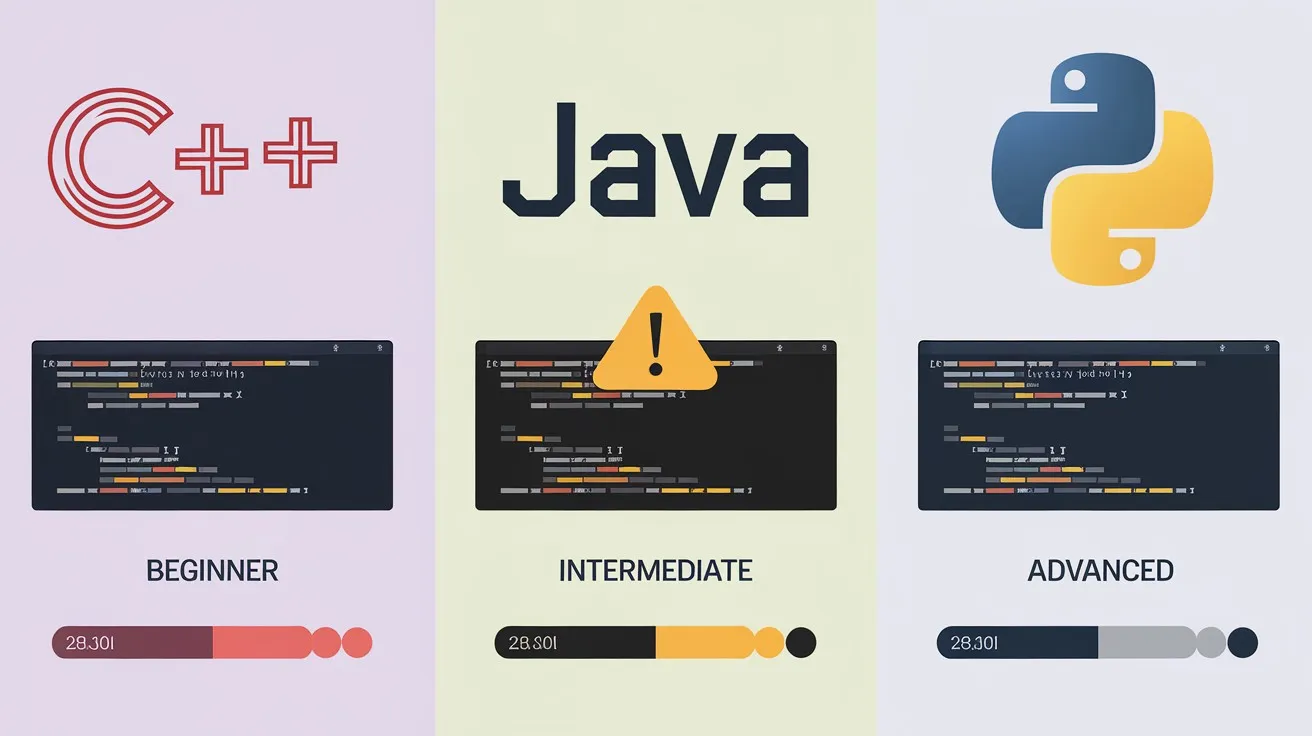Introduction
In the realm of programming, choosing the right language is crucial for the success of a project. C++ vs Java vs Python are three of the most prominent languages, each with unique features, advantages, and ideal use cases. This comprehensive guide delves into their differences, providing code examples to illustrate key concepts.
Understanding the Core Differences Between C++ vs Java vs Python
C++ is a statically typed, compiled language known for its performance and control over system resources. It supports both procedural and object-oriented programming paradigms.
Java is a statically typed, compiled language that runs on the Java Virtual Machine (JVM), promoting portability across platforms. It emphasizes object-oriented programming and has built-in garbage collection.
Python is a dynamically typed, interpreted language celebrated for its simplicity and readability. It supports multiple programming paradigms, including procedural, object-oriented, and functional programming.
Syntax Comparison: How C++ vs Java vs Python Differ in Code Structure
Let’s examine how each language implements a simple “Hello, World!” program:
C++:
#include <iostream>
int main() {
std::cout << "Hello, World!" << std::endl;
return 0;
}
Java:
public class HelloWorld {
public static void main(String[] args) {
System.out.println("Hello, World!");
}
}
Python:
print("Hello, World!")
Key Observations:
- C++ requires explicit inclusion of headers and a main function.
- Java mandates defining a class and a main method.
- Python offers a concise syntax without the need for explicit function or class definitions for simple scripts.
Performance Analysis: Speed and Efficiency in C++ vs Java vs Python
Performance is a critical factor in language selection:
- C++: Offers high performance due to direct compilation to machine code, making it suitable for system-level programming and applications where speed is paramount.
- Java: Utilizes the JVM, which introduces some overhead. However, Just-In-Time (JIT) compilation optimizes performance during runtime.
- Python: Being an interpreted language, Python is generally slower than C++ and Java. Its performance is adequate for many applications but may not be ideal for performance-critical tasks.
Memory Management: How Each Language Handles Resources
- C++: Requires manual memory management using pointers and dynamic allocation, providing fine-grained control but increasing the risk of memory leaks and errors.
- Java: Features automatic garbage collection, reducing the likelihood of memory leaks and simplifying memory management for developers.
- Python: Also employs automatic garbage collection, with a focus on simplicity and ease of use.
Object-Oriented Programming: Implementation in C++ vs Java vs Python
All three languages support object-oriented programming (OOP), but their implementations vary:
- C++: Supports multiple inheritance and provides features like operator overloading.
- Java: Supports single inheritance with interfaces to achieve multiple inheritance-like behavior.
- Python: Supports multiple inheritance and offers dynamic typing, allowing for flexible and rapid development.
Example: Defining a Class in Each Language
C++:
class Animal {
public:
void speak() {
std::cout << "Animal speaks" << std::endl;
}
};
Java:
public class Animal {
public void speak() {
System.out.println("Animal speaks");
}
}
Python:
class Animal:
def speak(self):
print("Animal speaks")
Use Cases: When to Choose C++ vs Java vs Python
- C++: Ideal for system/software development, game development, and applications requiring high performance and resource management.
- Java: Suitable for enterprise-level applications, Android app development, and large systems requiring portability and scalability.
- Python: Best for web development, data analysis, artificial intelligence, and rapid application development due to its simplicity and extensive libraries.
Community and Ecosystem: Libraries, Frameworks, and Support
- C++: Has a mature ecosystem with numerous libraries like Boost and frameworks such as Qt for GUI development.
- Java: Offers a vast array of libraries and frameworks, including Spring for enterprise applications and Hibernate for ORM.
- Python: Boasts a rich ecosystem with libraries like Django and Flask for web development, and NumPy and pandas for data analysis.
Elaborative Comparison Table: C++ vs Java vs Python
This table provides a detailed comparison of C++ vs Java vs Python across multiple categories to help you choose the right language for your needs:
Aspect | C++ | Java | Python |
Type of Language | Compiled, statically typed | Compiled and interpreted, statically typed | Interpreted, dynamically typed |
Performance | Very high performance due to direct machine code compilation | Moderate performance; relies on the JVM and JIT compilation | Slower compared to C++ and Java due to line-by-line interpretation |
Ease of Use | Complex; steep learning curve | Moderate; easier than C++ but more verbose | Very easy; beginner-friendly syntax |
Portability | Platform-dependent (compiled code is specific to the hardware) | Highly portable (bytecode can run on any JVM-enabled system) | Highly portable; runs on any system with a Python interpreter |
Compilation/Interpretation | Compiled directly into machine code | Compiled to bytecode, then interpreted or JIT-compiled by the JVM | Interpreted at runtime; optionally compiled to bytecode (.pyc) |
Memory Management | Manual memory management using new and delete | Automatic garbage collection | Automatic garbage collection |
Object-Oriented Support | Fully supports OOP; also supports procedural and generic programming | Fully supports OOP; enforces object-oriented design | Fully supports OOP; also supports procedural and functional programming |
Multiple Inheritance | Supported via virtual inheritance | Not directly supported (can be simulated with interfaces) | Supported |
Operator Overloading | Supported | Not supported | Not supported |
Syntax | Verbose, explicit | Moderate verbosity | Minimal, clean, and highly readable |
Error Handling | Exception handling (try-catch) | Exception handling (try-catch-finally) | Exception handling (try-except-finally) |
Standard Library | Smaller standard library compared to Python or Java | Extensive standard library and APIs | Extremely extensive standard library and third-party libraries |
Popular Libraries/Frameworks | Boost, Qt, OpenCV | Spring, Hibernate, Apache Commons | NumPy, pandas, TensorFlow, Django, Flask |
Concurrency | Thread-based, complex; requires manual management | Built-in threading, better suited for concurrency | Threading is available but limited by the Global Interpreter Lock (GIL); async programming recommended |
Best Use Cases | System software, game development, real-time applications | Enterprise applications, Android apps, large-scale systems | Web development, data science, artificial intelligence, scripting |
Community Support | Long-standing, mature community | Large and active community | Very large and vibrant community |
Development Speed | Slow; requires writing more boilerplate code | Moderate; less boilerplate compared to C++ | Very fast; minimal boilerplate and high-level abstractions |
Code Execution Example | Compiled and executed on hardware | Compiled to bytecode, then executed on the JVM | Interpreted directly or executed via a Python interpreter |
Typing System | Static (type checking at compile time) | Static (type checking at compile time) | Dynamic (type checking at runtime) |
Error-Prone Areas | Pointers, manual memory management, undefined behavior | Verbosity, need for JVM | Runtime errors due to dynamic typing |
Learning Curve | Steep; suitable for experienced programmers | Moderate; suitable for intermediate programmers | Very gentle; excellent for beginners |
Cross-Platform Support | Limited; needs recompilation for different platforms | Excellent; runs on any system with a JVM | Excellent; runs wherever a Python interpreter is available |
Real-Time Use Cases | Operating systems, embedded systems, video games | Banking systems, Android apps, enterprise-level software | Machine learning, data visualization, web development |
Community Popularity | Popular in academia, competitive programming, and systems programming | Popular for enterprise and app development | Popular in AI, data science, and web development |
Execution Speed (General) | Fastest | Moderate (faster than Python) | Slowest |
Syntax Simplicity | Complex, low-level | Moderate | Simplest and high-level |
Key Insights from the Comparison Table
- For High-Performance Needs: Choose C++ when raw performance is essential, such as in game development or system-level programming. Its direct machine-code compilation ensures unparalleled execution speed but requires significant expertise in managing memory and debugging.
- For Cross-Platform Applications: Opt for Java when building portable applications that must run seamlessly on various systems. The JVM makes Java ideal for large enterprise systems and Android applications.
- For Rapid Development: Use Python for projects requiring quick prototyping or for fields like data science, artificial intelligence, and web development. Its simple syntax and extensive libraries make it a favorite among developers.
By carefully considering the strengths and limitations outlined in this table, you can make informed decisions about which language is best suited for your project.
Conclusion
Choosing between C++ vs Java vs Python depends on the specific requirements of your project, including performance needs, development speed, and the problem domain. Understanding the strengths and trade-offs of each language will enable you to make an informed decision that aligns with your development goals.
























